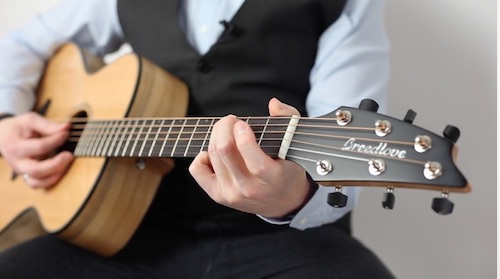Basic Arpeggio Exercise

Basic Arpeggio Exercise Hi, I'm Grey and this is Hub Guitar. I'm going to walk you through some basic arpeggios from the C major scale, played in the open position. The basic chords in the C major scale are: C major, D minor, E minor, F major, G major, A minor and B diminished. Each of these chords is built in thirds from the C major scale, meaning you take the root note, skip one scale note, and the next note is in the chord; then you skip another scale note, and the next note is also in the chord. Let's do a couple examples. C major. C, skip D, go to E. So we need C and E. From E, skip F, and go to G. So we have C - E and G in our C major chord. Let's try D minor. D, skip E, go to F. From F, skip G, and go to A. The D minor chord has D-F and A. Here are all of the arpeggios. C major [ demonstrate] D minor [ demonstrate ] E minor [ demonstrate] F major [ demonstrate ] G major [ demonstrate ] A minor [ demonstrate ] B diminished [ demonstrate] That's it! Learning these arpeggios will strengthen your knowledge of the C major scale, of melodic movements and motions, of the notes in the open position. All very good things.
Basic Arpeggio Exercises
The arpeggioA chord whose notes are played in succession, as if it were part of a melody, as opposed to all together in harmony. represents a neglected area of guitar practice. The vast majority of guitar players start off by learning chordA harmonic structure (that is, the combination of several notes) which ideally produces a pleasing sound. Chords are normally created by stacking notes in groups of thirds.s, some end up moving on to scaleA sub-set of notes taken from the larger set of 12. The smaller set (usually 5 or 7) is used to build melodies and chords.s so they can learn to play lead. But few ever thoroughly study arpeggioA chord whose notes are played in succession, as if it were part of a melody, as opposed to all together in harmony.s, which are a basic building block connecting the two.
How to Study Arpeggios
In the beginning, you will likely learn to get comfortable with the open position. This is where your first chords are to be found, and likely your first scale as well. Why not learn to play some of those chords in your repertoire as arpeggios?
First, we’ll need to know what the notes are in the chord.
Chords in C major
The open chords in C major can be constructed by the notes: C, D, E, F, G, A and B.
| Chord name | Notes |
| C | C, E, G |
| D- | D, F, A |
| E- | E, G, B |
| F | F, A, C |
| G | G, B, D |
| A- | A, C, E |
| Bo | B, D, F |
Constructing the Arpeggio
Next, for each chord we will play all of the possible arpeggio notes in the current (open) position, from lowest to highest. So for our C major arpeggio, we will play all “C”, “E” and “G” that are available to us, starting from the lowest and moving to the highest.
Note that, although these shapes may be very similar to chord shapes you already know, you should not attempt to play them merely by fretting chords. That’s because the notes of an arpeggio are ideally heard separately, and not allowed to ring together at the same time as they would in a chord.
The Open String Arpeggios
C Major Arpeggio

D Minor Arpeggio

E Minor Arpeggio

F Major Arpeggio

G Major Arpeggio

A Minor Arpeggio

B Diminished Arpeggio
Note that we don’t play the “G” string at all for this arpeggio.

Key Tasks
- Practice the arpeggios carefully, making sure the notes don’t blend together.
- Name the notes as you practice— understanding the notes is key to arpeggio practice.
 As the creator of Hub Guitar, Grey has compiled hundreds of guitar lessons, written several books, and filmed hundreds of video lessons. He teaches private lessons in his Boston studio, as well as via video chat through TakeLessons.
As the creator of Hub Guitar, Grey has compiled hundreds of guitar lessons, written several books, and filmed hundreds of video lessons. He teaches private lessons in his Boston studio, as well as via video chat through TakeLessons.